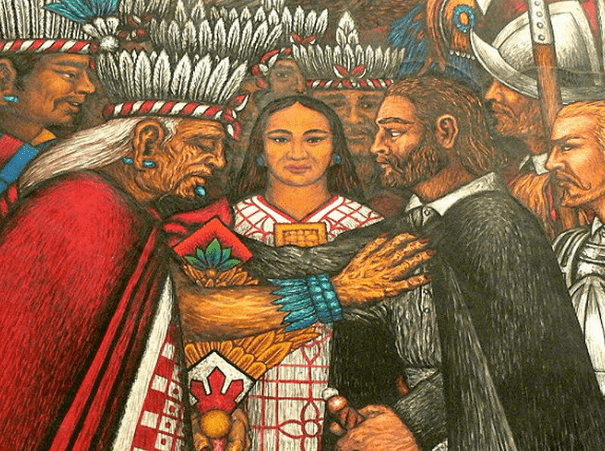Winner of the Fall 2016 StMU History Media Award for
Best Article in the Category of “People”
Best Article in the Category of “World History”
Largely due to the importation of disease and use of superior weapons, the Spaniards were able to conquer the Aztec capital of Tenochtitlan, kill the empire’s last emperor, Cuauhtémoc, and bring the Aztec empire to an end. Few know of La Malinche, the indigenous interpreter of Hernán Cortés, whose linguistic abilities were used to facilitate important conversations between the Spaniards and the indigenous leaders. Without the help of La Malinche, perhaps the Aztec empire would have survived.
Born between 1502 and 1505, La Malinche was named Malinalli Tenepal, the first part of her name being a Nahuatl term for the twelfth day of the month in correspondence to the Aztec calendar, and the second part of her name meaning “lively.” She was born of nobility in Paynala within the region of Veracruz. Her troubles started at a young age after the death of her father. La Malinche was ousted from her home to ensure her new half-brother received the inheritance of the family instead of her, since she was the eldest child. She was given to “some Indians of Xicalango.”1 Then the Indians gave her to a nobleman in Tobasco, a region in the Yucatan. When Cortés arrived to Tobasco, he was offered twenty slaves, one of them being La Malinche. Having lived in Veracruz, a Nahuatl-speaking region, and then being sold into a Maya-speaking region, La Malinche knew both languages and she was soon recognized for the linguistic talents that could benefit Cortés in his conquests.2

The few glimpses of La Malinche and how her presence as an interpreter accelerated the fall of the Aztec empire can be found in the writings of the Spanish explorers, specifically from Hernán Cortés, her “lord and master.”3 From the second letter Hernán Cortés wrote to Emperor Charles V, dated October 30, 1530, Cortés speaks of La Malinche as “a female interpreter that I had, who was a native of this country, and whom I obtained at Putunchún on the Rio Grande.”4 This confirms the vague aspects of her life that we already know. But most importantly, in this context, this letter goes on to tell of a scenario in which La Malinche saved the Spaniards from an ambush by the Cholulans. La Malinche was told by the wife of a native leader that they planned to attack the Spaniards and if La Malinche came with them, she would be protected. La Malinche delivered this message to Cortés, which ultimately led to the massacre of Cholula and provided a direct path to march towards Tenochitlan, the capital of the Aztec empire.5 This leads to the question of whether or not La Malinche was a traitor or a survivor. Did she explicitly want the Aztec empire to fall or did she just want to save herself from the carnage?
With no traces of primary sources from La Malinche herself, her story has been retold by various scholars without much consistency, nothing ever being certain. Up until the twentieth century, La Malinche was viewed as a traitor to her country Mexico. In 1861, on the celebration day of Mexico’s Independence, Ignacio “El Nigromante” Ramírez, a Mexican journalist, addressed the Mexican people by saying, “One of the mysteries of fate is that every Mexican owes his downfall and disgrace to a woman, and to another woman his salvation and glory; the myth of Eve and Mary is reproduced everywhere; we indignantly remember Cortés’s mistress and will never forget, in our gratitude to Doña María Josefa Ortiz.”6 La Malinche is seen as playing a key role in the subjugation of the Mexican peoples to Spain, while Doña María Josefa Ortiz did the contrary and liberated the country. However, many Chicana writers and modern scholars are trying to rewrite the tale of La Malinche to understand the complexities of her choices and to vindicate her. For example, Gloria Anzaldua promotes the idea that La Malinche had a “new consciousness,” that she voluntarily served as the interpreter of Cortés not only to save herself, but also because she knew that a new mestiza culture was going to be born (especially considering she had a son with Cortés in 1524).7 She made a conscious effort to exchange language and cultural aspects from each side in order to facilitate the emergence of the new mestiza society; however, with that came brutal consequences in the shape of warfare and mass death in the New World.
Whether or not La Malinche’s role as Cortés’s interpreter was traitorous, simply an effort to survive, or some other complex reason involving love for Cortés, hate for the Aztec empire for the cruelty she faced after being ousted from her home, or promotion of the new mestiza culture, no one will ever know the true story of the Indian, slave woman who traveled alongside Cortés towards the culmination of the Aztec empire.
- Bernal Castillo del Díaz, The Discovery and Conquest of Mexico, 1517-1521 rev. American ed., trans. A.P. Maudsley (New York: The Noonday Press, 1965), chap. 22-23. ↵
- Pilar Godayol, “Malintzin/ La Malinche/ Doña Marina: re-reading the myth of the treacherous translator,” Journal of Iberian and Latin American Studies 18, no. 1 (April 2012): 61-68. ↵
- Castillo del Bernal, chap 23. ↵
- Hernan Cortes to Emperor Charles V, October 30, 1520, in Letters of Despatches of Hernando Cortes, to the Emperor Charles V., trans. (New York: Wiley and Putnam, 1843), letter II. ↵
- Hernan Cortes to Emperor Charles V, October 30, 1520, in Letters of Despatches of Hernando Cortes, to the Emperor Charles V, letter II. ↵
- Rosario Pérez-Lagunes, “The Myth of La Malinche: From the Chronicles to Modern Mexican Theater” (PhD dis., Virginia Polytechnic Institute and State University, 2001), 24. Although she was of Spanish descent, Doña María Josefa Ortiz was born in Valladolid, Mexico in 1768 and identified herself as Mexican. She and her husband were both a part of the rebellion that ultimately led to Mexico’s independence from Spain in 1824. ↵
- Godayol, 68-70. ↵



230 comments
Lesley Martinez
This article does a great job of making this topic interesting. I was unaware of “La Malinche,” nor that she was Hernan Cortes’s interpreter. Regardless of whether she was a traitor or survivor, it seems that she had to look out for herself since at first, she was renounced by her family, sold to Indians, and then sold into slavery. It’s intriguing to know that Chicana writers and modern scholars are trying to rewrite the story of La Malinche to understand different aspects of her life. Great article!
Hailey Rodriguez
The author of this article did a nice job of telling this story in an interesting, creative way. Before reading this article I had never heard of “La Malinche” I hadn’t even thought about how the Aztecs and Spaniard’s would’ve communicated if it wouldn’t have been through a translator like La Malinche herself. If it hadn’t been for the fact that she was having a baby with Cortes, it would have been easier to make the argument that she is a survivor and not a traitor.
Samuel Vega
Immediately I noticed the awards for your article, congratulations Mariana for the double recognition. As I began reading the article I thought La Malinche was a traitor because of the downfall that the Spaniards brought to the Aztec empire. At the end of the article I could understand the argument for survivor. I lean towards survivor. La Malinche’s life is a lesson in survival. She learned a second language because she had to. Knowing she was a slave, implies another form of survival. She could not have known the destruction that would result with the Spanish invasion. She was sold to Cortez and did what she needed to do to survive.
Aaron Sandoval
This article although shorter than most was well done, especially with a topic such as this in a time period when not much was recorded or known. Was this article does well is that it brings to light a major historical figure that rarely gets covered, yet without her much of modern-day central America as we know it would be drastically different. This piece also does a good job of having us question what La Malinche’s intentions were in helping Cortés.
Zachary Kobs
This is my first time being introduced to the history of “La Malinche” and her interpreter influence on the downfall of the Aztec empire. After reading the article I feel as though no judgments should be made without proper citation as the article states that her “story has been retold by various scholars without much consistency, nothing ever being certain”. Traitor or not she made the decision for reasons she took to her grave and that we will never know.
Antonio Holverstott
This event in the history of the Americas demonstrates the principle of the smallest actions can have the largest consequences and in this case, this was the downfall of the Aztec Empire caused by Spain invading their land. Even though she thought her actions had good intentions for herself, Cortes, country, or any combinations of these factors, what she did for Cortes was still morally wrong. She led them to kill and oppress people who did not attack Spain first.
Jose Chaman
This is the first time that I have heard about La Malinche, and I just realize that in Mexico there is resignation towards this historical character for the supposed fact of having betrayed his nation and having made possible the Conquest of Tenochtitlan at the hands of General Cortes. I also learned the relationship between him and her, being her the interpreter of the conqueror.
Jakob Juergens
I’ve always been interested in the downfall of the Aztec Empire . Its nice to see an article viewing La Malinche as more then just a traitor to her country . Because honestly its easy to look back in history and point fingers and pick sides. We will never truly understand the terror of seeing a new race and mistaking it for a “Gods” . They would not have been able to fight back against or counter the destructive power the introduction of the Plague , religion, and weapons/technology brought from Europe by the Spaniards to the natives could have been . She was probably trying to survive the best way she could.
Nicole Ortiz
I had never heard of the story of La Malinche until coming across this article. I feel like she could have been the translator as a tactic to ensure her survival but i also feel like it was done because she developed a relationship with Cortez. Whatever the case may be, the concept itself is still interesting and this article did a good job at trying to explain each of the different possibilities as to why La Malinche did what she did.
Todd Brauckmiller Jr.
Seems like a difficult case when determining if La Malinche was a traitor or a survivor. To be honest even I can’t tell what her true intentions were, if I had to make a choice I’d say she did it to survive. When in a life-threatening situation some people do whatever it takes to stay alive. Though we may never know the truth behind her decision, a great and well informed article.